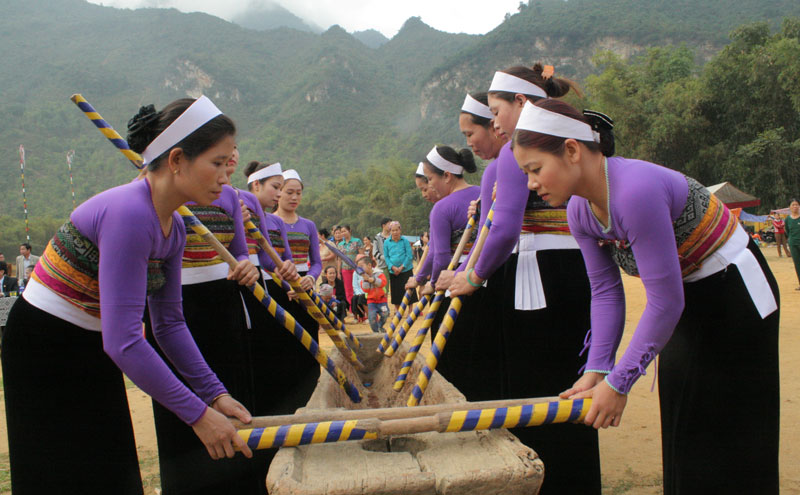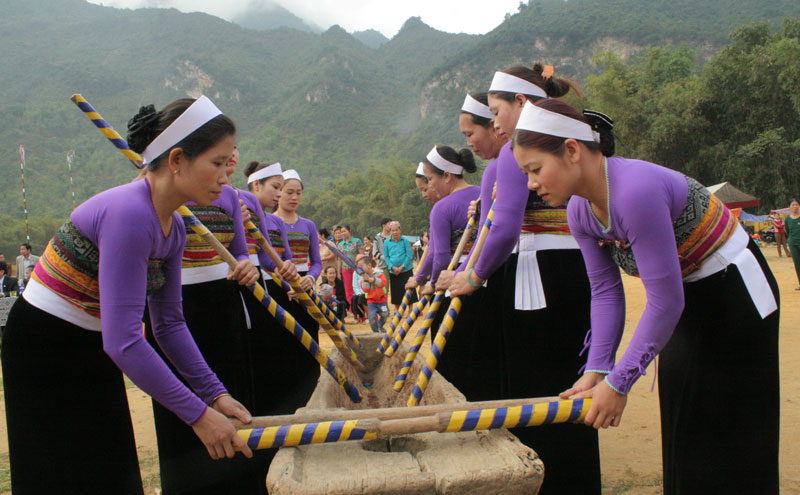



In recent years, Mai Chau district has focused on preserving and promoting the national cultural values. In the photo: Keeng Loong dance of the Thai ethnic people is performed in the events and the festivals.
The roofs on stilt-houses are built high, with a large and open space in front and the streams gurgling day and night. Mai Chau has many ethnic groups, of which, Thai group accounts for about 60% of the population. The district has developed a scheme to preserve and develop the cultural values of Thai people. Thai people in Mai Chau have been preserving and promoting the cultural values in daily life, the stilt-houses, the costumes, the writing etc. 85% of Thai households still retain traditional stilt houses.
The rehabilitation of brocade waving is focused by the district. There are 300 brocade weaving looms in the whole district. The district has also established the groups of brocade weaving, producing towels, cushions, pillows and traditional Thai costumes to meet the market demand.
In the district, the conservation and restoration of the festivals of the ethnic groups have also been focused on. In particular, Cha Chieng festival shows the special cultural feature, the affection, the gratitude, the creativity in production and artistic activities. The boys and girls are free to explore and love each other. The whole village have been enjoying the results of the labor and the cultural achievements, being immersed in the stories about heaven and earth, the community activities and stories.
Besides, the People have preserved a lot of antiques and objects such as the ancient Thai books, the laws of Muong ethnic people and Le Muong (from the 17th and 18th centuries), the hunting and gathering tools (catapuls - crossbows, hooves – wild chicken hunting traps, Lang Say – Do, Op, Phun Lu- fishing nets, Sam Dien - eel fishing tools); the labor tools (Kieu - sickle, sow – picking tools); clothes ( Tin and Com shirts and blouses and skirts; jewelry (Sai Soai- Xa Tich, Pooc Kho – necklaces, Pooc Khen- bracelets made of bronze and silver ); Mo tools (Dap - sword, statue - altar); the cooking utensils (stales – vegetable picking tools, Pan - rattan trays); the food processing tools (Long - mortar by hand, Moong - mortar by foot); the ancient coins (Ngan Kip - banknotes, kittens - ancient coins); the porcelain jars of the mandarins, the bronze gongs ... They are considered as sacred artifacts handed down from generation to generation, having the profound spiritual significance at the same.
With the available geographical features and cultural traditions, the Party Committee, the authorities and the People of all ethnic groups in Mai Chau have been preserving and promoting the cultural identity effectively. At the same time, they have been promoting the tourism potential to introduce people all over the world the rich cultural characteristics of the land and people here. Along with that, the district has also been mobilizing the resources to invest in infrastructure, implementing the specific solutions to improve the business environment to attract organizations and individuals to invest in the tourism field. They have been associating the construction of tourism products with the preservation of the good traditional cultural values, contributing to promoting socio-economic development in the locality.